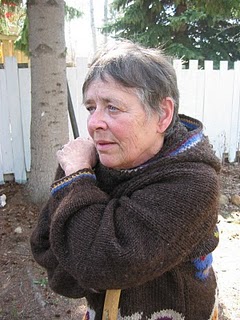By David Climenhag
David Climenhaga’s Alberta Diary
January 7, 2011

(Saint City News photo.)
This column appeared in today’s edition of the Saint City News.
I often see Elke Blodgett in the distance, trudging across Ray Gibbon Drive toward Big Lake. Winter or summer, rain or sunshine, it doesn’t seem to matter. There she is, a tiny determined dynamo.
Even in the distance, reduced to not much more than a dot on the landscape, there’s something very forceful about this small person. No passerby — even someone from Saskatchewan or B.C. — could fail to recognize that the figure on the horizon knows exactly where she is going.
Elke is, you see, not just a passionate advocate for our natural environment, she is herself a force of nature. Indeed, such is her forcefulness that it’s impossible for an old journalist, set in his ways after three decades in the trade, to refer to her by last name alone, as if she were merely a mayor, major general, deputy minister or corporate president.

(Photo by Alan Henderson.)
No, Elke is Elke! In many ways, I have learned in the years since my family moved to St. Albert, she is among the best friends this community has. Since she came here from Europe via the U.S. in 1966, the seventy-something Elke has battled the city on pesticide use, the location of roads, the ugly mess in our old landfills, ill-considered plans to make inroads into our watershed and the location of bird-killing power lines.
Often, I am sorry to report, her wise counsel is ignored, and we are worse off for it. But Elke persists with determination, stinging wit and bushels of facts. Ask her a question about a local environmental issue, as I have from time to time, and you’re likely to get an email with more facts than you can manage, then another and another!
As a retired person, she’s got both time and energy to attend city council meetings, speak forcefully and, if necessary, be a thorn in a councillor’s side. Yes, Elke can be a gadfly, in the sense she is someone who persistently cajoles, criticizes, demands and offers solutions.
I know that some city councillors have dealt with this by trying to ignore her — which seems a bit like trying to ignore the rising tide. The smarter ones pay attention to what Elke says because they know that, very often, she speaks for many St. Albertans.
This is why I was so pleased to read in the Saint City News that the City of St. Albert plans to name the peninsula at the Riel Stormwater Pond in her honour. “Elke’s Peninsula,” the city’s news release stated, is one of the preferred locations in our community for wetland birds to nest. Mayor Nolan Crouse observed that “it is fitting for Elke to be recognized and I can think of no better way of doing so than to name this area within the constructed wetlands after her.”
But, you know what, this honour doesn’t really go far enough. We need to listen up and take some of Elke’s advice about how to treat the wetland area around Elke’s Peninsula with the respect it deserves.
Unfortunately, it’s too late to put Ray Gibbon Drive, which runs beside Elke’s Peninsula, where Elke thought it belonged. But it’s not too late to do something about that infernal bird-killing power line, which needs to be relocated, preferably underground.
Yes, there will be costs. But since the city, the province and Altalink, the electrical transmission company, all look bad because of the damage done by the line in its present location, there should be plenty of motivation to share the pain and, to borrow some words from the city’s news release on Elke’s Peninsula, prove our commitment “to environmental protection and sustainability.”
After all, as I’m sure Elke would agree, our planned new wetlands bird-watching platform with a direct view of the adjacent power line, where thousands of visitors can watch birds die when they hit the lines, isn’t exactly going to put St. Albert on the map for environmental friendliness!
This post also appears on rabble.ca.